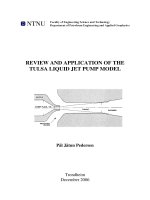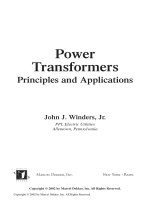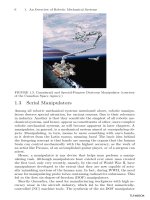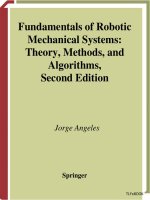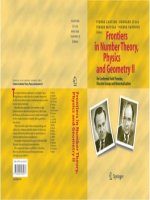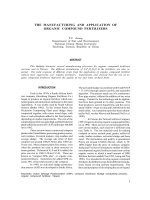inorganic electrochemistry - theory, practice and application 2003 - zanello
Bạn đang xem bản rút gọn của tài liệu. Xem và tải ngay bản đầy đủ của tài liệu tại đây (9.8 MB, 634 trang )
Inorganic Electrochemistry
Theory, Practice and Application Inorganic Electrochemistry
Theory, Practice and Application
P.
Zanello
University
of
Siena, Italy
RSmC
advancing
the
chemical
sciences
ISBN
0-85404-661-5
A
catalogue record for this book is available from the British Library
lc
The Royal Society of Chemistry
2003
All rights reserved
Apart from any fair dealing for the purpose of research or private study, or criticism or
review as permitted under the terms of the
UK
Copyright, Designs and Patents Act,
1988,
this publication may not be reproduced, stored or transmitted, in any form or by any means,
without the prior permission in witing
of
The Royal Society of Chemistr-v, or in the case
of
reprographic reproduction only in accordance bvith the terms of the licences issued by the
Copyright Licensing Agency in the
UK,
or in accordance with the terms of the licences
issued by the appropriate Reproduction Rights Organization outside the
UK.
Enquiries
concerning reproduction outside the terms stated here should be sent
to
The Royal Society
of Chemistry at the address printed
on
this page.
Published by The Royal Society of Chemistry,
Thomas Graham House, Science Park, Milton Road, Cambridge CB4
OWF,
UK
Registered Charity Number
207890
For further information see our web site at www.rsc.org
Typeset by Alden Bookset, Northampton, UK
Printed by
TJ
International, Padstow, Cornwall, UK
iv
Preface
The use of electrochemical measurements to determine the ability of
inorganic molecules to undergo electron-transfer processes has become a
routine tool in synthetic chemistry (‘just like elemental analysis and
spectroscopic techniques). Nevertheless, the first approach of researchers
to electrochemistry is often on an approximate basis (it often happens, in
quoted journals, that a few cyclic voltammetric runs are assumed to
cover all the redox aspects of a molecule) in that electrochemistry books
are commonly not easily comprehensible to non-electrochemists and
even more rarely deal with ‘inorganic chemistry’ (in contrast with
the well-established tradition
of
‘organic’ electrochemistry). Thus, the
present book (which should be considered more an ‘applied inorganic
chemistry’ book than a ‘real electrochemistry’ book) aims to bridge the
gap between undergraduate and research level electrochemistry books,
in order to initiate inorganic chemists into electrochemical investiga-
tions in as straightforward a way as possible, as well as to introduce
electrochemists to the opportunities offered by the multiple fields of
inorganic chemistry.
Pure electrochemists might disapprove of some oversimplifications (or
find a few inaccuracies), but as an inorganic chemist
I
think that the main
targets of an electrochemical investigation are:
0
to determine
if
an inorganic compound is redox active
0
to measure the electrode potentials at which eventual redox changes
0
to state
if
the redox processes lead to stable species
0
in the case of derivatives which undergo degradation as a con-
sequence of electron transfer processes, to measure the rate
of
such
degradation paths, eventually suggesting those techniques which
can help the identification of the intermediate products
take place
V
vi
Preface
0
to suggest the proper chemical reagents to perform large-scale redox
processes
0
to throw light onto redox paths through comprehensive electrode
mechanisms, the latter having to be always based on well docu-
mented experimental evidence (complicated speculative mechanisms
are almost always tedious and not useful)
0
to point out eventual molecular dynamics triggered by electron-
transfer processes.
The selection of the matter treated in the text was dictated by the
conflicting requirements of controlling its length and offering a satis-
factory survey of the use of electrochemistry in inorganic chemistry (in
this connection, I wish to express my gratitude to Jean-Marc Lievens and
Emanuela Grigiotti for their invaluable graphic help). It is therefore
possible that the text appears incomplete with respect to some important
topics. Readers, however, must keep in mind that it simply constitutes a
first approach to inorganic electrochemistry targeted at the newcomers,
even if we hope that it might be of some help also to the practitioners, in
that the different subjects are updated as much as possible.
Unfortunately (or better, fortunately) chemical innovation
is
very fast
and any matter rapidly ages. Perspectively, the dynamic aspects
of
inorganic compounds
(or,
‘molecular machinery’) will become more and
more sophisticated (their interpretation thus requiring also more and
more sophisticated electrochemical techniques), but the basic equipment
to their operation will remain in some ways still valid for a long time
(screws, bolts, screwdrivers, pliers and drills are still basic pieces of the
actual super-technological assemblies). In this picture, it
is
expected that
the basic approach outlined here, to face with the electrochemical aspects
of a number of topics in inorganic chemistry, will (hopefully) maintain its
middle-term validity.
Contents
Introduction
1
BASIC ASPECTS OF ELECTROCHEMISTRY
Chapter
1
Fundamentals
of
Electrode Reactions
7
1
Electron Transfer Reactions
7
2 Fundamentals
of
Electron Transfers at
an Electrode
10
2.1 The Electrode/Solution System
11
2.2
The Nature
of
Electrode Reactions 12
2.3 The Current as a Measurement
of the Rate
of
an Electrode Reaction 14
2.4 The Potential as a Measurement
of the Energy of the Electrons Inside
the Electrode 15
Current and Potential 16
3 Potential and Electrochemical Cells 16
4 Kinetic Aspects of the Electrode Reactions 22
4.1 Electron Transfer
22
4.1.1 A Deeper Insight into the Meaning
of
k"
and
a
26
4.1.2 Verification
of
the Theory Under
Equilibrium Conditions 28
4.1.3 Further Considerations
on
the Fundamental Equation
of the Electron Transfer
Process. The Exchange Current 30
4.2 Mass Transport 34
Possible Ways to Move
a
Species
from the Bulk
of
the Solution
to the Electrode Surface
35
2.5 The Biunique Relationship Between
4.2.1
vii
viii
Contents
4.2.2 Linear Diffusion at a Planar
Electrode
4.2.3 Spherical Diffusion
4.2.4 Concentration Profiles.
Cottrell Equation
4.3 Influence of Mass Transport
on Charge Transfer. Electrochemically
‘Reversible’ and ‘Irreversible’ Processes
5
Non-Faradaic Processes. Capacitive Currents
6 The Electrical Double Layer.
A
Deeper
Examination
6.1
The Kinetic Consequences of the Double
Layer Composition on the Electron
Transfer
References
Chapter
2
Voltammetric Techniques
1
Cyclic Voltammetry
1.1 Reversible (Nernstian) Processes
1.1.1 Diagnostic Criteria to Identify
a Reversible Process
1.1.2 The Chemical Meaning of
an Electrochemically Reversible
Process
1.2
Irreversible Processes
1.2.1 Diagnostic Criteria to Identify
an Irreversible Process
1.2.2 The Chemical Meaning
of an Electrochemically
Irreversible Process
1.3 Quasireversible Processes
1.3.1 Diagnostic Criteria to Identify
a Quasireversible Process
1.3.2 The Chemical Meaning
of an Electrochemically
Quasireversible Process
1.4 The Effect of Chemical Reactions
Coupled to Electron Transfers
1.4.1 Preceding Chemical Reactions
1.4.2 Following Chemical Reactions
1.4.3
A
Chemical Reaction Interposed
Between Two Electron Transfers
1.4.4 Electrocatalysis
1.5
Consecutive Electron Transfer Processes
36
38
38
42
43
45
46
48
49
49
51
55
57
59
60
62
62
64
66
67
68
74
87
93
99
Con
tents
1.5.1
Two Reversible One-electron
Transfers
1.5.2
Two One-electron Transfers with
Different Extents
of
Reversibility
1.6
Adsorption Processes
to Cyclic Voltammetry
2.1
Pulsed Voltammetric Techniques
2
Electrochemical Techniques Complementary
2.1.1
Differential Pulse Voltammetry
2.1.2
Square Wave Voltammetry
2.2
Hydrodynamic Techniques
2.3
Controlled Potential Electrolysis
2.4
Chronoamperometry
2.5
2.4.1
Coupled Chemical Reactions
Determination of the Number of
Electrons Involved in an Electron Transfer
Process from the Correlation Between Cyclic
Voltammetry and Chronoamperometry
References
PRACTICAL ASPECTS
Chapter
3
Basic Equipment for Electrochemical Measurements
1
Electrodes
1.1
Indicator Electrodes
1.2
Reference Electrodes
1.3
Auxiliary Electrodes
2.1
Cells for Cyclic Voltammetry
and Chronoamperometry
2.2
Cells for Controlled Potential Electrolysis
Solvents and Supporting Electrolytes
References
2
Electrochemical Cells
3
Solutions for Electrochemical Studies.
APPLICATIVE ASPECTS
Chapter
4
The Electrochemical Behaviour
of
First
Row
Transition Metal Metallocenes
1
Ferrocenes
1.1
Monoferrocenes
1.2
Ferrocenophanes
ix
100
104
104
110
110
110
113
115
117
123
126
133
134
139
139
139
141
141
142
146
147
149
154
159
160
160
167
X
Con
tents
1.3
Olygoferrocene Derivatives
1.4
Ferrocene Polymers
1.4.1
Ferrocene-based Linear Polymers
1.4.2
Ferrocene-based Branched Polymers
(Dendrimers)
1.5
Recent Applications
of
Ferrocenes
1.5.1
Ferrocenes as Electrochemical
1.5.2
Ferrocenes as Materials Displaying
Sensors
“on-Linear Optical Properties’
2
Vanadocenes
3
Chromocenes
4
Manganocenes
5
Cobaltocenes
6
Nickelocenes
References
Chapter
5
The Electrochemical Behaviour
of
Transition
Metal Complexes
1
Vanadium Complexes
2
Chromium Complexes
3
Manganese Complexes
3.1
The Role
of
Manganese Complexes
in Photosynthesis
3.2
Tetranuclear Manganese Complexes
Modelling the Photosynthetic Water
Oxidation Site
3.2.1
Derivatives
of
Diamantoidal
3.2.2
Derivatives
of
Cuboidal Geometry
3.2.3
Derivatives
of
Planar Geometry
3.2.4
Derivatives
of
Butterfly Geometry
3.2.5
Derivatives
of
Linear Chain
3.2.6
Derivatives
of
Layered Geometry
The Role
of
Manganese Complexes
in Material Science
Geometry
Geometry
3.3
4
Iron Complexes
4.1
Intramolecular Electronic Communication
in Polynuclear Iron Complexes
5
Cobalt Complexes
5.1
Intramolecular Electronic Communication
in Polynuclear Cobalt Complexes
6
Nickel Complexes
171
182
182
185
193
193
198
204
205
207
20
8
210
21
1
217
219
230
236
244
25 1
25
1
252
253
256
258
260
262
263
274
276
288
290
Contents
7
Copper Complexes
8
Zinc Complexes
References
Chapter
6
Metal Complexes Containing Redox-active Ligands
1
Ferrocenes as Ligands in Metal Complexes
2
Fullerenes as Ligands in Metal Complexes
2.1
Intramolecular Electronic Communication
3
Dioxolenes (and Their Imino Analogues) and
Dithiolenes as Ligands in Metal Complexes
4
Porphyrins (and Tetraazaporphyrins)
as Ligands in Metal Complexes
5
Less Known Redox-active Ligands
in Metal Complexes
References
in Metallo-bis(ful1erenes)
Chapter
7
Electrochemically Induced Structural Modifications
1
Geometrical Isomerization
2
Some Examples of Molecular Reorganizations
Induced by Deprotonation or Dehydrogenation
3
Reversible Migration of a Hydrogen Atom
from a Metal Centre to a Peripheral Ligand
4
Reversible Orientation from ‘Perpendicular’
to ‘Parallel’ Disposition of an Alkyne Group
Bridging Two Metal Centres
Irreversible Electron-Transfer Pathways
Quasireversible Electron-Transfer Pathways
References
5
Redox Transformations Following
6
Redox Transformations Following
Chapter
8
Transition Metal Clusters
1
Metal-Sulfur Clusters
1.1
M3S,
(~1=2, 4)
1.2
M4Sn
(n
=
3-6)
1.3
1.4 M9S9
M6S,
(n=
6, 8, 9)
2
Metal-Carbonyl Clusters
2.1
M3(C0)12, LM3(CO)II]2- (M
=
Fe, Ru,
0s)
2.2
[Fe4(CO)13]
-,
M4(C0)12 (M
=
Co, Rh, Ir)
M
=
Rh,
n
=
1)
2.4
[M6(C0)15]2- (M
=
Co, Rh, Ir),
2.3
[M-j(CO)lSln- (M
=
OS,
~1=
2;
xi
302
3 14
316
325
325
332
346
348
363
371
3 74
38
1
38
1
392
397
399
402
404
407
409
409
409
414
419
42
1
422
422
42
5
426
xii
Chapter
9
The Reactivity
of
Transition Metal Complexes
with Small Molecules
1
The Reactivity of Transition Metal Complexes
with Oxygen
1.1
Metal Complexes which React Irreversibly
with Dioxygen
1.2
Metal Complexes which React Reversibly
with Dioxygen
1.3
Hemoprotein-like Metal Complexes
1.4
Hemocyanin-like Metal Complexes
1.5
Haemerythrin-like Metal Complexes
2
The Reactivity of Transition Metal Complexes
with Dinitrogen
2.1
Metal Complexes with Terminal
2.2
Metal Complexes with Bridging
2.3
Metal Complexes with Terminal
3
The Reactivity of Transition Metal Complexes
with Dihydrogen
References
Coordination to One Dinitrogen Molecule
Coordination to One Dinitrogen Molecule
Coordination to Two Dinitrogen Molecules
Chapter
10
Superconductors in Electrochemistry
1
General Aspects of Superconductivity
1.1
Physical Properties of Superconductors
1.1.1
The Loss of Electrical Resistance
1.1.2
The Meissner Effect and Levitation
1.1.3
The Mechanism of Superconductivity
1.2
Chemical Properties
of
High
T,
Superconductors
1.2.1
Svnthesis and Oxidation States
Contents
OF
1-2-3
Superconductors
504
43 1
432
433
436
438
440
440
442
443
445
445
446
449
452
466
467
469
474
476
482
484
49
1
497
497
499
499
500
502
504
Contents
Xlll
2
1.2.2 Molecular Structure of 1-2-3
Superconductors
505
Electrochemical Aspects
of
Superconductors 506
2.1 The Preparation and Use of Electrodes
of
Superconducting Materials 507
2.2 Study of the Corrosion of Ceramic
Superconductors 508
2.3 Electrochemical Synthesis
of Superconductors 512
2.4 Electrochemistry Using Electrodes
of Superconducting Materials
at Temperatures Below
T,
513
References 514
Chapter 11
Molecular Metal Wires: An Electrochemical
Inspection 517
1
Platinum Blues 519
2 Chloride-Bridged Triruthenium Complexes 522
3 Oligo-2-Pyridylamides as Bridging Ligands
in Polynuclear Linear Complexes 524
3.1
Trinuclear Complexes 524
3.2 Tetranuclear Complexes 528
3.3 Pentanuclear Complexes 528
3.4 Higher Nuclearity Complexes 530
4
Isocyanides and Nitrile Ligands in Polynuclear
Linear Complexes 532
References 533
Chapter 12 The ‘Direct’ Electrochemistry
of
Redox-active
Proteins 539
1
Introduction 539
2 Electrochemistry of Cytochromes 542
3 Electrochemistry of Iron-Sulfur Proteins 556
4 Electrochemistry of Blue Copper Proteins 567
References 574
Chapter 13 Linear Correlations Between the Redox Potential
and Other Chemical and Physico-chemical
Parameters 579
1
2 Redox Potential and Solvent Effects 589
References 602
Redox Potential and Electronic Effects
of the Ligands 579
3 Redox Potential and Temperature 594
xiv
Appendices
Physical Constants
SI
Base Units
Derived
SI
Units
SI
Prefixes
Conversion Factors
The
Greek Alphabet
Subject Index
Contents
603
603
603
603
604
604
605
607
Introduction
In order to understand the basic aspects of an electrochemical
investigation on inorganic molecules (in its widest meaning, of any
molecule which contains at least one metal centre) it must be taken into
account that in these molecules the metal-ligand bonds are prevailingly
covalent type. Since electrochemical techniques allow one to add or
remove electrons in a controlled manner, it is conceivable that the
addition or removal of electrons inside these molecules can lead to the
formation of new bonds or to the breakage of existing bonds.
The first target of Inorganic Electrochemistry is therefore to study the
effects of such electron addition/removal processes on the molecular
frames.
As a matter of fact, the structural consequences of the electron
exchanges are governed by the bonding, anti-bonding or non-bonding
character of the frontier orbitals
of
the molecule. When one removes an
electron from the energetically more easily accessible occupied molecular
orbital (HOMO), which for instance possesses bonding character, it is
clear that the molecular frame is weakened. The same happens, when one
adds an electron to the energetically more easily accessible unoccupied
molecular orbital (LUMO),
if
it possesses anti-bonding character.
For instance let us consider the case of the tetrahedral carbonyl cluster
[Rh4(CO)12], together with the theoretical analysis of its molecular
orbitals, Figure
1.
The lowest energy unoccupied orbital (LUMO
-
27e)
is
anti-bonding
with respect to the Rh-Rh bonds. As a consequence, the addition of
electrons to [Rh4(CO)12] would cause destruction of the molecular frame
(see Chapter
8,
Section
2.2).
Actually,
if
we look at the cyclic voltammogram of a non-aqueous
solution of [Rh4(CO)12] shown in Figure
2,
we see a reduction profile
(peak
A)
which lacks a directly associated re-oxidation peak in the
reverse scan.
1
2
Introduction
Figure
1
Molecular structure and theoretical analysis
of
(Rhd(C0)
121
-2.0
peak
A
peak
A
Figure
2
Cyclic voltammogram exhibited by [Rh4( CO)
12]
in dichloroethane solution.
From hereafter the symbol
will indicate the starting potential
As
we will discuss in Chapter
2,
such an ‘unsymmetrical’ pattern
foreshadows fragmentation or severe structural reorganization of the
original molecular frame.
Obviously, the addition or removal
of
electrons can also lead to
less drastic geometrical effects if the molecular orbitals involved are
non-bonding.
Consider, for instance, the case of ferrocene, [Fe(y-C5H5)2], which,
according to the 18-electron rule,
is
highly stable.
As
one can deduce
from its orbital diagram shown in Figure
3,
its highest occupied orbital
(HOMO
-
a’,)
possesses a non-bonding character; this means that if we
remove one electron from such an orbital, we do not trigger breakage of
the molecule.
In agreement with such an electronic distribution, the cyclic
voltammogram of ferrocene displays an oxidation profile (peak
A)
which is accompanied in the reverse scan by a directly associated
reduction process (peak
B),
Figure
4.
As
we will discuss, such a ‘symmetric’ profile is typical of an electron
removal which does not lead to important structural changes. In fact, the
17-electron ferrocenium ion, [Fe(C5H5)2]
+
,
generated upon oxidation,
is
a stable species which substantially maintains the original molecular
frame (but for the fact that, because of the electron removal, the iron-
carbon bonds are slightly weakened and hence elongated by about
0.04
p\
with respect to the neutral parent; see Chapter 4, Section 1.1).
Introduction
3
Figure
3
Molecular
&
orbital diagram
of
ferrocene
peak
0
Figure
4
Cyclic voltammogram exhibited by
[Fe
(C,H,)2]
in dichloromethane solution
Finally, it must be taken into account that electrochemistry not only
points out the occurrence
of
redox changes at molecular levels and their
possible structural consequences, but also determines the electrode
potentials at which such electron exchanges take place. For instance,
Figure
4
shows that the [Fe(C5H5)2]/[Fe(C5H5)2]
+
oxidation takes place
at
E"
=
+0.44
V
(as we will see later, with respect to the experimental
4
Introduction
conditions used). For inorganic chemists such quantitative information
can be of interest in that it allows them to calibrate properly the power
of
the eventual oxidizing agents to be used in a large-scale preparation
of
ferrocenium salts.
BASIC ASPECTS
OF
ELECTROCHEMISRY
1
Fundamentals
of
Electrode Reactions
Electrochemistry is essentially based on the relationships between
chemical changes and flows of electrons
(i.e.
the passage of electricity).
In this connection it is well known that electron transfer processes play
an essential role in many physical, chemical and biological mechanisms
and a number of such examples will be illustrated in the text. Perhaps in
no other field of chemical reactivity has one looked for and found
so
many relationships between theory and experimental measurements.
Two disciplines cover the majority of the theoretical and practical
aspects of the mechanisms through which electron transfers proceed:
electrochemistry
and
photochemistry.
In this book only mechanisms
relating to electrochemistry will be considered.
1
ELECTRON TRANSFER REACTIONS
In
a
purely formal manner the description of an electron transfer event,
such as the reduction in solution of Fe(II1) ion, can be written in two
ways, depending on whether the reduction is operated by
a
chemical
agent or by an electrode:
0
through a reducing agent
(redox reaction in a
homogeneous
phase):
[Fe(H20>6I3+
i-
[v(H2O)6l2+
-
[Fe(H20)6I2+
f
[v(H2O)6l3+
0
through an electrode
(redox reaction in a
heterogeneous
phase):
[Fe(H206)l3+
+
e-
-
[Fe(H20)6I2'
In both cases, the adopted symbolism only gives a picture of the
overall process. In fact, from a mechanistic viewpoint, the redox
reactions (as with any other type of reaction) proceed by a series of
intermediate steps involving phenomena such as:
7
8
Chapter
1
dzfusion
of the species through the solution;
interaction between reagents,
in the case of reactions in a homogen-
ous
phase, or interactions between reagents and electrode, in the
case of reactions in a heterogenous phase;
formation
of
short-
or
long-lived intermediates
due to variations in
electronic configurations,
to
the eventual substitution of ligands,
etc.
Commonly, oxidation-reduction reactions in a homogenous phase are
outer-sphere
reactions;
inner-sphere
reactions.
In the inner-sphere reactions, the process involves a 'transition state'
in which a mutual strong penetration of the coordination spheres of the
reagents occurs (and, therefore, strong interaction between reagents),
whereas in the outer-sphere reactions there is no overlap of the
coordination spheres of the reagents (and, therefore, there is weak
interaction between reagents).
The classical example of inner-sphere mechanism is the reduction of
the Co(II1) salt [Co(NH&C1I2+ by Cr(I1) ions ([Cr(H20),l2+):
classified as:
[
CO"'(NH~)~CI]~++
[
CTII(H~O)~]
2+
-
5H+
5H7O
[
CO"(H~O)~]~++
[
Cr111(H20)5C1]2++
5NHi
The fact that from a chloro-cobalt complex a chloro-chromium
complex is formed, suggests that the reaction must proceed through an
intermediate state that enables the transfer of a chlorine atom from
cobalt to chromium. The proposed mechanism for this reaction is:
[
Cr"(H,0)6]2++[ CO"'(NH~)~C~]~+-
{[(H20)5Cr11
-
C1- Co1"(NH3),]4++H;0
i
I
electron transfer
{[(H20)5Cr"1
-
C1- CO"(NH~)~]~-~
hydrolysis
(H',
HzO)
I
[CO"(H20)6]2+
+
5NH:
Fundamentals
of
Electrode Reactions
9
It is assumed that the intermediate product is [(NH3)5Co"'-Cl-
Cr11(H20)5]4+
:
in which there is a clear overlap of the coordination spheres of the two
reagents. It follows that the electron-transfer can take place only after
such an intermediate has formed.
As
an example of a reaction which involves an outer-sphere
mechanism the following reaction can be considered:
In this case one may assume that the charge transfer takes place as soon
as the two reagents collide, without the occurrence of any exchange of
ligands (which would imply breaking of old or formation of new bonds
in the reaction intermediate).
As
a consequence, the mechanism with which a homogeneous reaction
proceeds is conditioned by the rate of either the
ligand exchange
or the
electron transfer.
An outer-sphere mechanism
is
certainly active when the
exchange of ligands between reagents is slower than the exchange of
electrons between reagents.
In this picture, the electron transfer processes mediated by metallic
electrodes (redox reactions in a heterogeneous phase) can also be
classified to proceed according to outer-sphere or inner-sphere mechan-
isms (obviously, considering the electrode surface as a reagent).
One can define as outer-sphere electrode processes those in which the
electron transfer between the electrode and the active site occurs through
the layer of solvent directly in contact with the electrode surface. The
electrode and electroactive species are, therefore, separated such that the
chemical interaction between them can be considered practically nil
(obviously, apart from their electrostatic interaction), see Figure
1.
Inner-sphere electrode processes
are defined as those in which the
electron exchange occurs between the electrode and the electroactive
species (the metal core or its ligand) that are in direct contact with the
electrode surface, see Figure
2.
It should be emphasized that the majority of electrochemically
induced redox processes in inorganic chemistry proceed (or are assumed
to proceed) through outer-sphere mechanisms.
